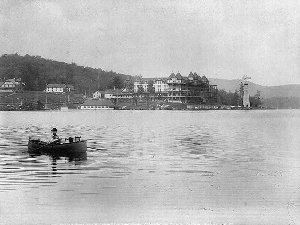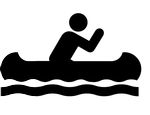A whole new industry revolving around recreational tourism opened in the park during the late 19th and early 20th centuries as economically prosperous families looked for an escape from city life. In order to support the growing guiding industry, where hired woodsmen lead clients through the wilderness, an entirely new boat was created by local residents (see Boat History & Design section). While the average canoe is lightweight, it lacks the space preferable for long-duration trips. The Adirondack skiff, otherwise known as a guide boat, was the perfect compromise between weight and size when it was created in the 1820s (Bond). The skiff allowed guides to maneuver and lead clients over vast lakes and through serpentine streams without compromising agility or speed. With this new design, the boats were just as easy to carry as a canoe but only required a single person to row (Bond).

Paddler in an Adirondack Guideboat on Blue Mountain Lake in the Adirondacks. (Seneca Ray Stoddard/Wikimedia)
The age of recreation is still going strong in the Adirondacks. The local economy benefits from money brought into the park by paddlers by way of guiding, outfitting and renting gear. One of the official tourism websites of the Adirondacks boasts of the 30,000 miles of rivers and streams and the 3,000 lakes and ponds that flow throughout the park (visitadirondacks.com). While this includes water with whitewater rapids as well as flat water, there is no shortage of water on which to canoe and kayak.
_______________________________________________________________________________________________________
Works Cited:
1. Bond, Hallie E. Boats and Boating in the Adirondacks. Syracuse, NY: Adirondack Museum, 1995. N. pag. Print.
2. "Canoeing & Kayaking." Adirondack. N.p., 2015. Web. 06 Apr. 2015. < http://visitadirondacks.com/recreation/canoeing-kayaking
Photos:
1. Paddler in an Adirondack Guideboat on Blue Mountain Lake in the Adirondacks. (Seneca Ray Stoddard/Wikimedia) (http://commons.wikimedia.org/wiki/File:Prospect_House,_Blue_Mountain_Lake_-_1889_-_Stoddard.jpg)

